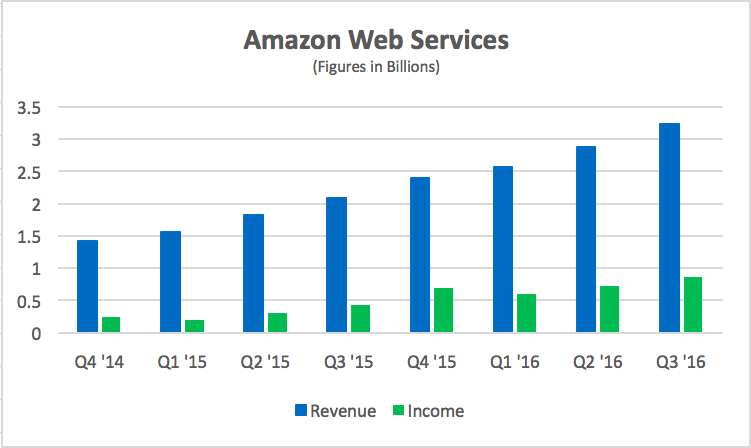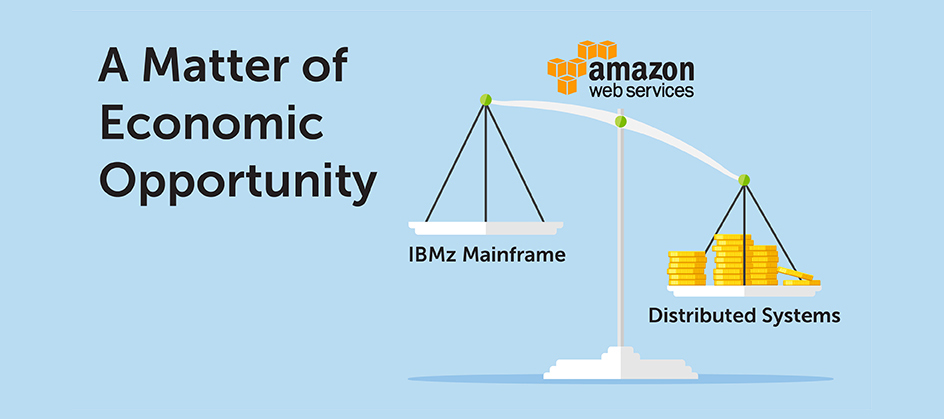The IBMz mainframe is the most powerful, scalable and secure platform on the planet. It’s also the most TCO-efficient. If you have any doubts about that, just take a look at these blogs: “Turn Out The Lights…The Party’s Over! Mainframes Rout Commodity Servers!” and “VMware’s Success = Distributed Computing’s Failure in Masquerading as a Mainframe.”
But if the IBMz mainframe is so awesome, why isn’t Amazon Web Services selling IBMz as a Service?
The answer is quite revealing. And it tells us why enterprise CIOs must quickly make some very smart forward-looking decisions about how they manage their mainframe applications.
Owning internally-managed, distributed infrastructure is a fool’s errand
Amazon has been able to build AWS into a multi-billion-dollar business because distributed infrastructure is absurdly expensive to own. By the time you build underlying physical infrastructure, layer virtualization on top of it, staff a team for your incredibly burdensome deployment and management operations, equip that team with configuration and security tools, and start juggling your wildly fluctuating workloads, you’ve spent a fortune. And you still have performance, availability, security and compliance problems.
In fact, TCO for on-premise infrastructure is so outlandish that AWS has a huge addressable market for Infrastructure-as-a-Service at price that is both economically compelling to customers and nicely profitable for Amazon.

The code-word for this is “economies of scale.” But economies of scale are only worth something if economies of lesser-scale are horrific in comparison. Internally managed distributed infrastructure fits this bill perfectly and AWS has seized the opportunity with impressive and profitable revenue growth.
The superiority of mainframe economics
AWS doesn’t — and won’t — sell IBMz as a Service for the exact opposite reason: mainframe ownership is extremely efficient.
The elegant simplicity of the IBMz mainframe’s centralized architecture —combined with the collective effort of generations of dedicated mainframe professionals to perfect mainframe operations over multiple decades — has resulted in platform TCO that is almost incomprehensibly efficient. That doesn’t mean mainframe owners can’t measurably improve their mainframe TCO. They can and should. But there is nothing in the mainframe world that even comes close to AWS’s TCO arbitrage in the world of distributed computing.
Even IBM’s own mainframe outsourcing business struggles to deliver economic value on the mainframe. IBM GTS customers almost always see too little savings and too much degradation in service. That’s because the inherent efficiency of the mainframe leaves IBM almost no room for profit based on economies of scale. So, instead, IBM must eke out margin by reducing responsiveness, forcing the use of inferior tools, cutting corners, claiming out-of-scope fees and under-equipping a low-paid offshore staff that is less skilled and less engaged than the customer’s original mainframe professionals. This disappointment in the IBM GTS outsourcing and the urgent need to mainstream mainframe development to align with their distributed DevOps culture, Agile process and preferred toolchain is leading more and more enterprises to bring mainframe development and operations back in-house.
So where do mainframe customers need to take action?
The real challenge mainframe owners face isn’t mainframe TCO. It’s the mainframe application lifecycle. Entrenched, outdated lifecycle processes prevent mainframe owners from modifying and re-purposing their core COBOL. PL/I and Assembler code with the same speed and alignment with the business as they can with Java, C# and Swift.
Given the central importance of mainframe-hosted systems-of-record to their businesses — and given the compelling economics of in-house managed IBMz MIPS — the wisest course of action for enterprise CIOs is to re-tool mainframe application lifecycle processes so they fit into the broader world of Agile, DevOps and continuous delivery.
What’s a mainframe enterprise to do?
AWS as a distributed Infrastructure-as-a-Service provider makes a whole lot of business sense for both enterprise customers and Amazon shareholders. AWS produces a better service at a lower cost. Re-platforming mainframe applications as a cloud consumed service doesn’t make business sense for anybody. Rather, the focus must be on exploiting the unmatched virtues of the IBMz mainframe by transforming the way we write, update, integrate and extend those applications. That’s why every CIO should start re-tooling mainframe development, testing and operations to thrive within Agile/DevOps methods — TODAY!









0 Comments